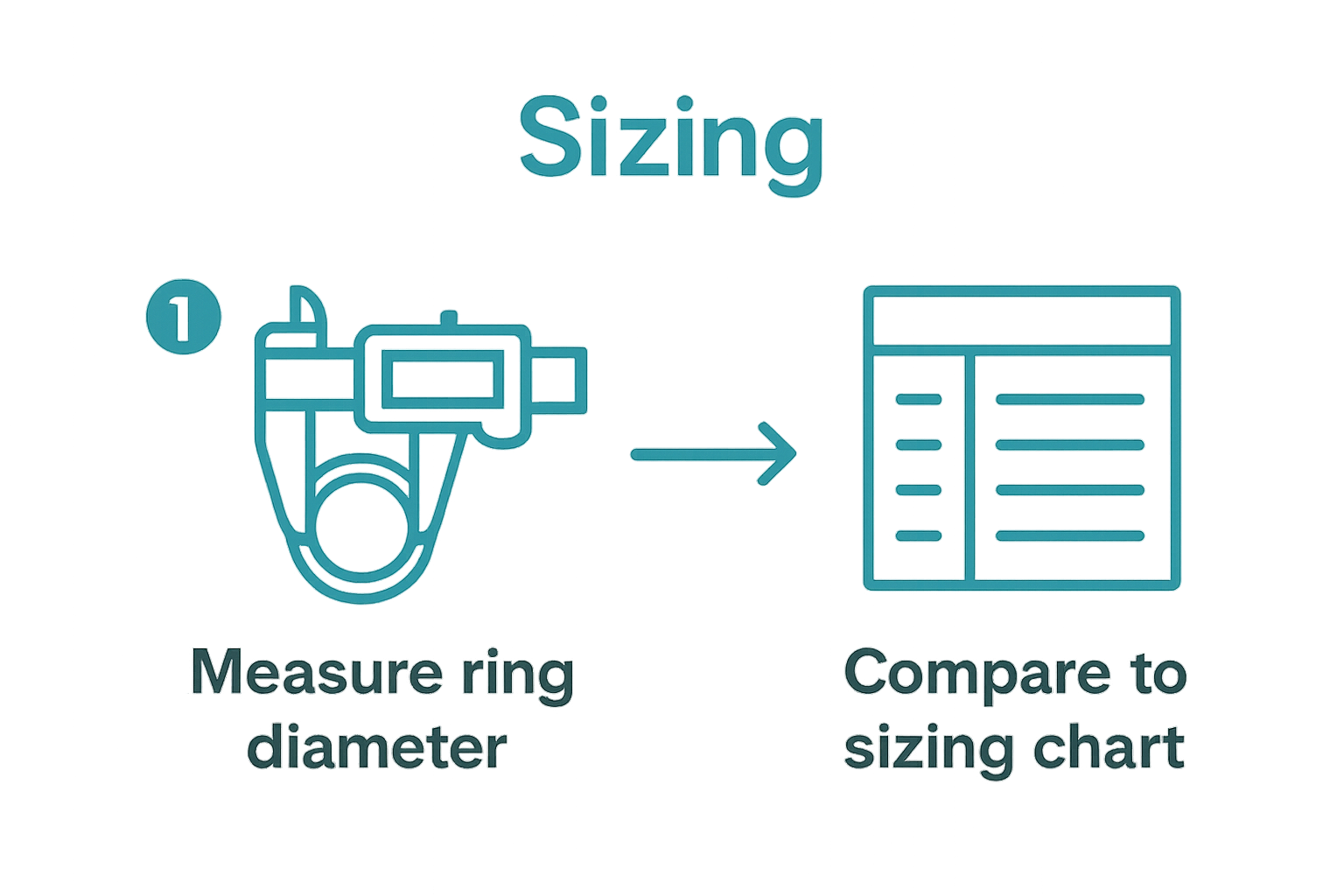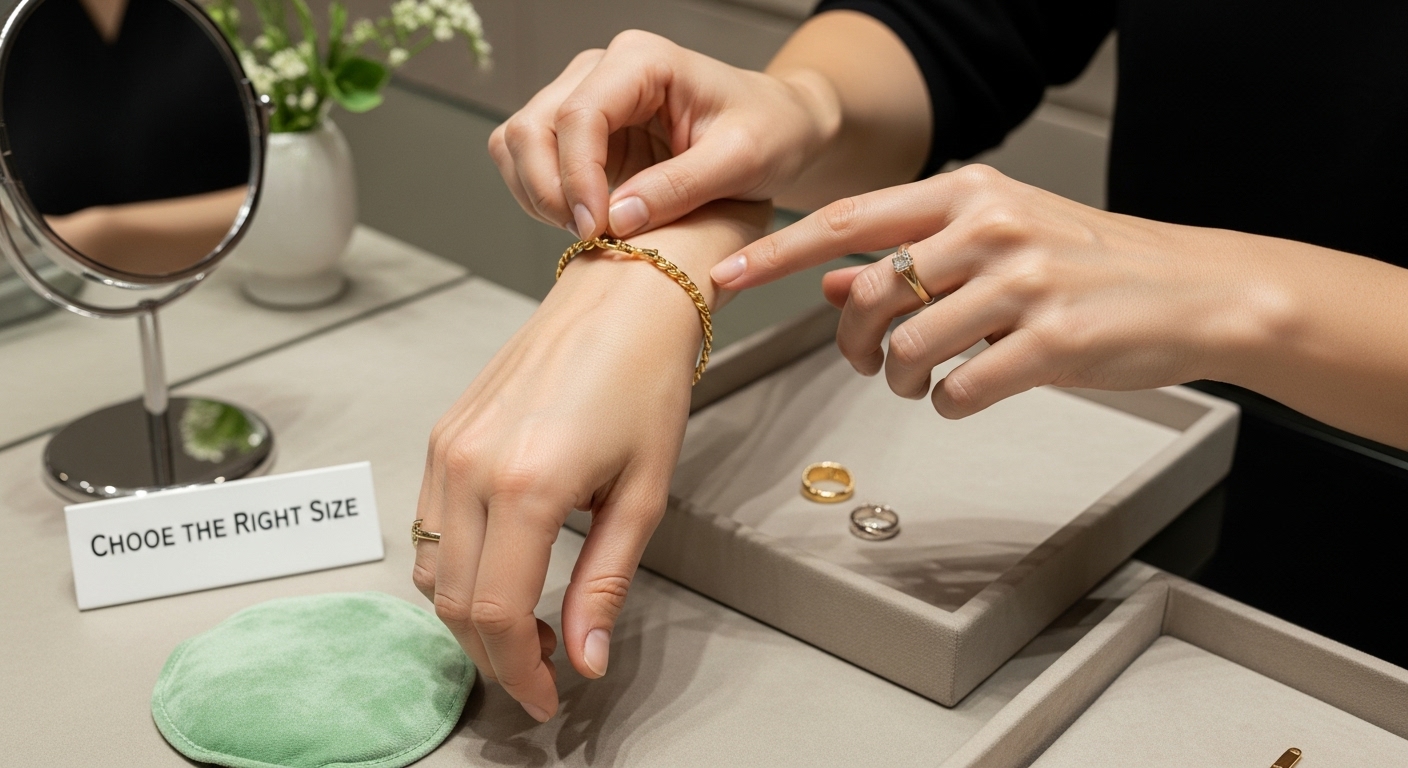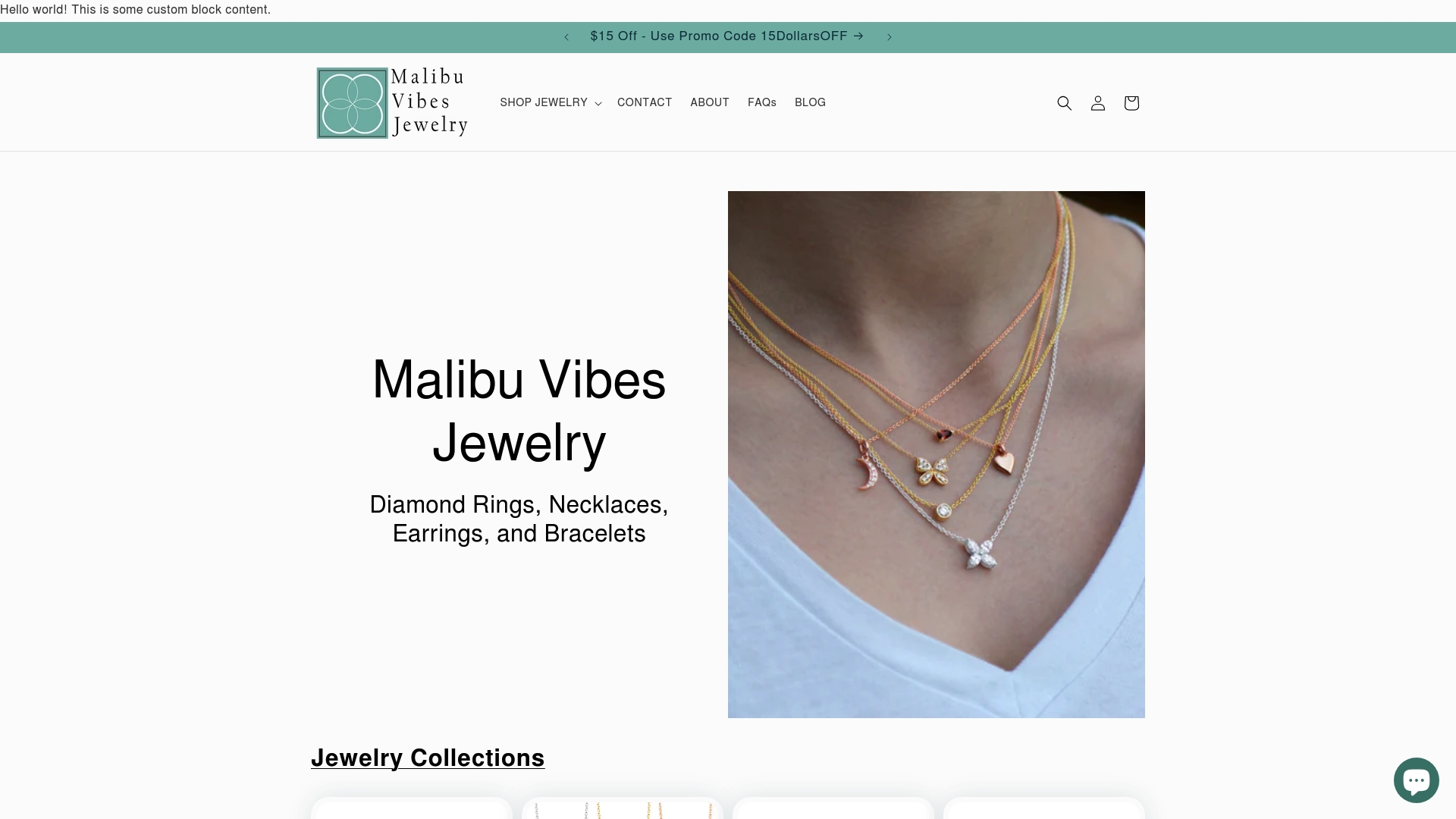Jewelry that fits just right does more than polish your look. It feels nearly invisible and effortlessly comfortable all day long. Yet, despite all the dazzling options out there, over 50 percent of people end up with rings or bracelets that do not fit quite right on the first try. That sounds surprising, especially when measuring seems so simple. Here is the hidden secret: getting the perfect fit relies less on luck and more on mastering a few smart measuring tricks most jewelry shoppers never learn.
Table of Contents
- Step 1: Gather The Necessary Tools For Sizing
- Step 2: Measure Your Finger Or Wrist Accurately
- Step 3: Consult The Jewelry Sizing Chart
- Step 4: Choose The Right Size Based On Your Measurements
- Step 5: Verify Your Selection With Quality Checks
Quick Summary
| Key Point | Explanation |
|---|---|
| 1. Gather precise measuring tools | Use digital calipers and flexible measuring tape for accurate jewelry sizing based on body contours. |
| 2. Measure at optimal times | Measure your fingers or wrist when warm for accurate readings, ensuring the material is snug but not tight. |
| 3. Consult sizing charts accurately | Use standardized international charts to convert your measurements into the correct jewelry sizes, noting variations. |
| 4. Account for design variations | Consider specific jewelry styles and widths, as they may require adjustments to standard sizing for a comfortable fit. |
| 5. Perform thorough quality checks | Inspect the jewelry visually and practically, ensuring secure settings and comfortable wear during normal movement. |
Step 1: Gather the Necessary Tools for Sizing
Accurate jewelry sizing requires precision and the right equipment. Before diving into measurements, you’ll need to assemble a collection of specialized tools that transform guesswork into exact science. Professional jewelers understand that precision starts with having the correct measuring instruments at your disposal.
For an effective sizing process, you’ll want to collect several key tools. Digital calipers stand out as the most critical instrument in your sizing toolkit. These remarkable devices provide measurements in both inches and millimeters with incredible accuracy, allowing you to capture precise dimensions of rings, bracelets, and other jewelry pieces. Metal calipers with sliding jaws enable you to measure both external and internal circumferences, which is crucial when determining the perfect fit.
In addition to digital calipers, a flexible measuring tape becomes essential for capturing wrist and neck circumferences. Unlike rigid measuring tools, a soft measuring tape conforms to body contours, providing more natural measurements for necklaces and bracelets. Learn more about precise bracelet measurements to ensure your accessories fit perfectly.
Additional recommended tools include:
- A clean, flat surface for stable measurements
- Pencil and paper for recording dimensions
- Magnifying glass for examining intricate details
Professional jewelers recommend calibrating digital tools before each use to maintain measurement accuracy. A quick test against a known reference point ensures your instruments provide consistent, reliable readings. When measuring, maintain a relaxed posture and keep measuring tools steady to avoid introducing errors.
By carefully selecting and preparing your measurement tools, you set the foundation for achieving the perfect jewelry fit. Each instrument plays a critical role in transforming rough estimates into precise sizing that guarantees comfort and elegance.
To help you prepare for accurate jewelry sizing, this table summarizes the essential tools you should gather, along with their specific purposes and any important recommendations.
| Tool | Purpose | Recommendations / Tips |
|---|---|---|
| Digital calipers | Precise measurement of jewelry dimensions | Calibrate before use; measures in mm and inches |
| Flexible measuring tape | Measuring wrist and neck circumference | Use soft tape for contour accuracy |
| Metal calipers (sliding jaws) | Measuring inner/external circumferences | Good for rings; ensure proper calibration |
| Clean, flat surface | Stable area for measuring | Prevents errors from movement |
| Pencil and paper | Recording dimensions | Keep detailed notes for reference |
| Magnifying glass | Examining intricate jewelry details | Check fine details and craftsmanship |
Step 2: Measure Your Finger or Wrist Accurately
Accurate measurement is the cornerstone of finding the perfect jewelry fit. Whether you’re selecting a delicate ring or an elegant bracelet, understanding how to capture precise dimensions will ensure comfort and style. The process requires patience, attention to detail, and a few strategic techniques that professional jewelers employ.
Finger measurements demand special consideration. Begin by measuring your finger at the end of the day when your hands are warm and at their natural size. Hands can fluctuate in size throughout the day due to temperature, activity, and fluid retention, so timing is crucial. Wrap a soft measuring tape or a strip of paper around the base of the intended finger, ensuring the material is snug but not constricting. If using paper, mark the point where the material overlaps, then measure the length against a ruler for precise tracking.
Learn more about precise bracelet measurements to complement your sizing technique. When measuring wrist circumference, use a flexible measuring tape positioned where you would typically wear a bracelet. Keep the tape comfortably loose without sagging, allowing room for natural movement. Pro tip: Add approximately half an inch to your wrist measurement for bracelets to ensure a comfortable fit that isn’t too tight.
Critical measurement considerations:
- Measure multiple times to confirm consistency
- Use room temperature water to reduce hand swelling if needed
- Consider width of the jewelry when determining final size
For rings, professional jewelers recommend measuring the inside diameter of a well-fitting ring you already own as a reference point. This provides a reliable baseline for new purchases. If you’re between sizes, always choose the larger size. A ring that’s slightly loose is more comfortable than one that pinches or feels restrictive.
Verify your measurements by cross-referencing with standard sizing charts, understanding that different jewelry styles might require slight adjustments. Some designs, like wide bands or rings with intricate settings, might need a slightly larger size to accommodate their unique structure. By approaching measurement with precision and care, you transform the sizing process from guesswork into a reliable method for finding your perfect jewelry fit.
Step 3: Consult the Jewelry Sizing Chart
Navigating jewelry sizing charts can feel like deciphering a complex code, but with the right approach, you’ll master this essential skill. These standardized reference guides transform your precise measurements into actionable sizing information, bridging the gap between your physical dimensions and the perfect jewelry fit. Professional jewelers rely on these charts as their definitive sizing reference, making them an indispensable tool in your jewelry selection process.
International sizing standards can vary significantly, which means a size 7 in the United States might differ from a size 7 in European measurements. According to research from the International Gem Society, comprehensive sizing charts account for these variations, providing conversion metrics across multiple international standards. When consulting these charts, match your exact measurement to the corresponding size, paying close attention to both numerical sizes and millimeter circumference.
Explore our fine jewelry making process to understand the precision behind our sizing recommendations. Ring sizing charts typically display a grid with numeric sizes running vertically and corresponding diameter measurements horizontally.
Look for the point where your measured circumference intersects with the standard size, which provides your most accurate fit. For bracelets and necklaces, charts often include length recommendations based on wrist or neck measurements.
Critical chart reading tips:
- Always use the most recent sizing chart from the specific jewelry manufacturer
- Compare your measurements against multiple reference points
- Consider potential seasonal variations in body measurements
Slight variations are normal, so don’t be discouraged if you find yourself between two sizes. In such cases, jewelers recommend choosing the larger size for rings and bracelets, ensuring comfort and preventing potential sizing complications. Some intricate designs, like wide bands or statement pieces, might require slight adjustments to your standard size.
Verify your sizing by cross-referencing measurements with the chart multiple times, ensuring consistency and accuracy.
 A methodical approach transforms sizing from an intimidating process into a precise, reliable method for selecting jewelry that fits perfectly. Remember that every piece of jewelry is unique, and these charts serve as expert guidance in your quest for the ideal accessory.
A methodical approach transforms sizing from an intimidating process into a precise, reliable method for selecting jewelry that fits perfectly. Remember that every piece of jewelry is unique, and these charts serve as expert guidance in your quest for the ideal accessory.
Step 4: Choose the Right Size Based on Your Measurements
Selecting the perfect jewelry size transforms a beautiful piece from merely attractive to genuinely comfortable and flattering. After meticulously gathering measurements and consulting sizing charts, you now enter the critical decision-making phase where precision meets personal style. Understanding nuanced sizing variations becomes your key to finding that ideal fit.
Ring sizing requires particularly careful consideration. According to research from the Gemological Institute of America, different ring styles demand unique sizing approaches. Wide band rings, for instance, typically require a slightly larger size compared to delicate, narrow bands. This accommodation ensures the ring slides comfortably over your knuckle while maintaining a secure fit at the base of your finger.
Explore our fine jewelry design process to understand the intricate considerations behind perfect sizing. When selecting bracelet sizes, consider your lifestyle and personal comfort preferences. A bracelet that fits too tightly can restrict movement, while one that’s too loose might slip off unexpectedly. Professional jewelers recommend leaving approximately half an inch of space between the bracelet and your wrist for optimal comfort and mobility.
Critical sizing decision factors:
- Consider your typical hand and wrist movements
- Account for potential seasonal weight fluctuations
- Evaluate the specific jewelry design and its inherent sizing requirements
Comfort and aesthetics must work in harmony. For necklaces, your neck circumference and personal style preferences play crucial roles. Shorter necklaces sit closer to the neck, while longer styles offer more versatility in layering and styling. If you’re between two sizes, err on the side of the larger measurement to ensure unrestricted movement and a more comfortable wear.
Verify your final size selection by performing a simple comfort test. Simulate typical daily movements while wearing the piece, checking for any pinching, sliding, or restriction. Remember that some metals and designs have minimal inherent flexibility, so choosing the right size from the start is paramount. By approaching sizing with thoughtful consideration and attention to detail, you’ll ensure your jewelry not only looks stunning but feels like a natural extension of your personal style.

Step 5: Verify Your Selection with Quality Checks
The final stage of jewelry sizing involves comprehensive quality verification, transforming your careful measurements into a confident purchase. This critical step ensures that your selected piece not only fits perfectly but meets the highest standards of craftsmanship and durability. Professional jewelers approach quality checks with meticulous attention to detail, understanding that true luxury lies in both precise sizing and exceptional construction.
According to the Federal Trade Commission’s Jewelry Guides, consumers should conduct thorough visual and tactile inspections before finalizing their purchase. Examine the piece under good lighting, checking for consistent metal coloration, smooth finishing, and secure stone settings. Run your fingers gently along the jewelry’s surface, feeling for any irregularities or rough edges that might indicate substandard craftsmanship.
Explore our fine jewelry making process to understand the intricate standards behind our quality control. When verifying sizing, perform a series of natural movement tests. For rings, ensure the piece slides over your knuckle smoothly and sits comfortably at the base of your finger without spinning or feeling constrictive. Bracelets should move freely without pinching, allowing approximately half an inch of movement around your wrist.
Critical quality verification steps:
- Check metal consistency and color uniformity
- Verify stone security and alignment
- Test movement and flexibility of the piece
- Examine clasp and connection mechanisms
Comfort and wearability are paramount. Simulate typical daily activities while wearing the jewelry, paying attention to how it interacts with your clothing, skin, and movement patterns. Slight adjustments might be necessary to achieve the perfect balance between aesthetic appeal and functional comfort. Professional jewelers recommend wearing the piece for short periods initially to assess its long-term wearability.
A comprehensive quality check extends beyond physical inspection. Verify the piece’s authenticity through accompanying certification, material composition documentation, and the reputation of the jewelry manufacturer.
Below is a checklist table to guide you through the critical verification steps recommended for ensuring your selected jewelry piece meets both sizing and quality expectations.
| Quality Check Step | What to Evaluate | Why It Matters |
|---|---|---|
| Check metal consistency | Uniform color and smooth finish | Confirms craftsmanship and durability |
| Verify stone security and alignment | Stones set securely and aligned | Prevents stone loss or discomfort |
| Test movement and flexibility | Comfortable fit during wear | Ensures practicality and comfort |
| Examine clasp and connections | Secure and smooth operation | Reduces risk of accidental loss |
| Simulate daily activities | Jewelry interaction with skin/clothes | Verifies real-world comfort |
| Review certification/documentation | Authenticity and material info | Confirms trustworthiness and quality |
Experience Precision Luxury with Perfectly Sized Jewelry
Struggling to find jewelry that fits as beautifully as it looks? Our guide uncovered the frustration of imprecise sizing and how it can turn a treasured piece into a source of discomfort. Whether you are concerned about accurate measurements for rings or searching for bracelets that feel just right, Malibu Vibes Jewelry transforms careful measurement into true comfort. Our handcrafted luxury pieces are designed to help you achieve the perfect fit every time you wear them. Discover our curated Bezel Jewelry collection, celebrated for its seamless lines that highlight the accuracy and craftsmanship you need for your keepsake accessories.

Ready to find a piece that fits your life and style without compromise? Shop directly at Malibu Vibes Jewelry and enjoy stunning, expertly sized accessories crafted in Los Angeles. Whether you’re choosing a statement ring or an everyday bracelet, our collections ensure you never have to sacrifice comfort for luxury. Explore today and secure the fit and elegance you deserve.
Frequently Asked Questions
How do I measure my finger for ring sizing?
To measure your finger, use a soft measuring tape or a strip of paper. Wrap it around the base of your finger at the end of the day, when your hands are warm. Mark where the material overlaps, then measure the length against a ruler for accurate dimensions.
What should I consider when choosing a bracelet size?
When choosing a bracelet size, measure your wrist where you would normally wear the bracelet using a flexible measuring tape. It’s recommended to add approximately half an inch to your wrist measurement for a comfortable fit that allows for natural movement.
How can I read a jewelry sizing chart effectively?
To read a jewelry sizing chart, match your measurements with the corresponding size listed. Pay attention to both the numerical sizes and the millimeter circumference. Understand that sizing standards can vary internationally, so use the most recent chart from the specific jewelry manufacturer.
Why is it important to verify the sizing of my jewelry?
Verifying the sizing of your jewelry is crucial for comfort and wearability. A properly sized piece will slide over your knuckle easily, fit securely, and allow for movement. Conducting a quality check helps ensure that the piece meets the highest standards of craftsmanship and fits as expected.



